In the second chapter of the daily journey made during the Western Desert in Egypt Kamal Expedition first touches the Gilf Kebir plateau and bows before the plaque that Almasy, The English Patient, placed in memory of Prince Kamal el Din in 1933 . arise incredible scenery, fascinating findings of the Second World War as a vehicle stuck in sand, improvised abandoned and enter the fray the first cave paintings route aerodromes.
|
|
|
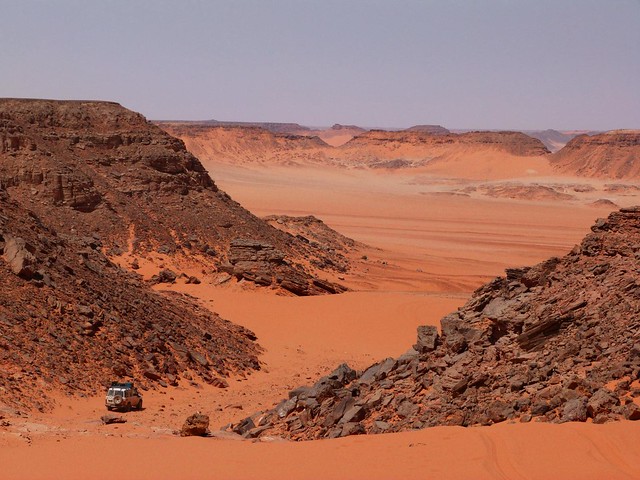
The adventure from this point it became even more interesting and the desert began to narrate his ear some of those secrets that make it such a special place. The team, already fully formed, fully enjoyed a facet of Egypt far removed from that of the temples and pyramids. That Egypt so unknown ...
March 16, 2014: Day 4
Certainly the landscape of today has become more and more radiant, less monotonous and if I hurry, more extraterrestrial every meter we go. The color palette went from white to yellow, then to red ocher or a fire to finish in plains and mountains of dyed black as coal. The exhibit runs and has passed several bills rolled as the front wheels burst and the inevitable traffic jams in the sand. Fortunately for every problem awaits a quick fix. Perhaps the biggest setback we have spent has been losing a part of the group for a while and they they ran into a patrol of the desert that has not stopped them from moving to be convinced that formed part of this expedition.
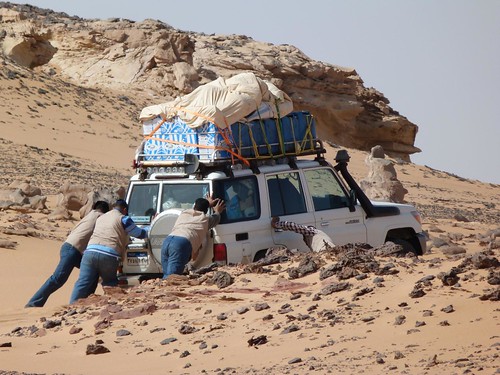
Otherwise after many kilometers yesterday today we have done everything possible to recover the lost distance, but neither have been able to achieve the goal of 8-Bells, but we have been forced to camp in the dunes about 35 kilometers. Always we try to settle time before sunset to assemble "our snack bar" with enough light.
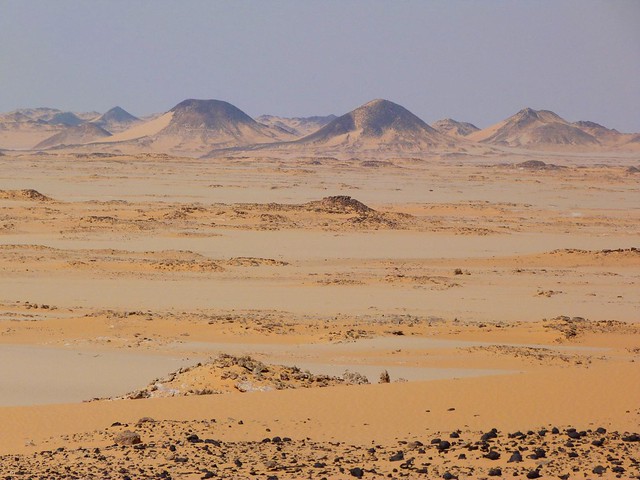
Car World War II stuck in sand
In addition to the panoramic plains, mountains and dunes in the shape of the back of a whale bright gold, we made a little trip back in time. Or rather, two. Because we have encountered more material of the Second World War in this car stuck in the sand since the early forties case. First we saw the skeleton of a Ford Model A truck with an intact front and some cans of gasoline around. Laszlo Almasy identical one used for more than one issue, but British troops would be those that serve as vehicles to transport these goods needed in the isolated oasis were also protagonists in the war.
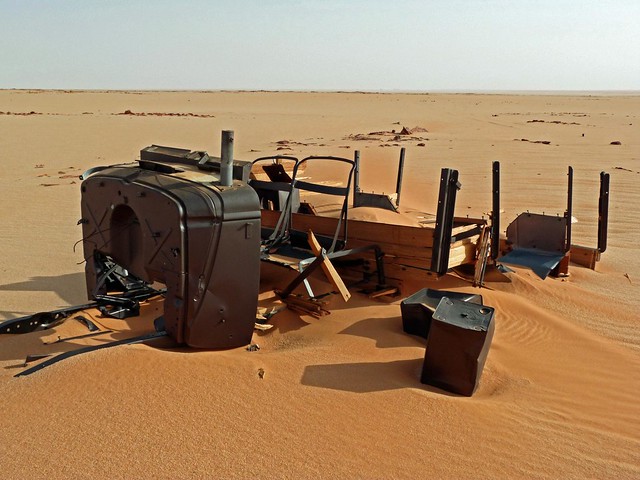
But for beauty another truck manufactured by Chevrolet swallowed by the sand just a kilometer ahead. The metal blackened by the sun, never rusty because here the rain does not give you for never appear, is already part of such a lonely and unknown landscape that is possible to find vestiges like elsewhere in the world would not have lasted two minutes.
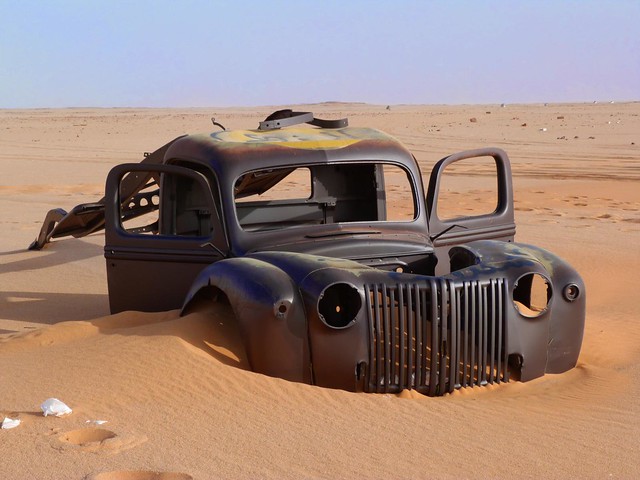
One wonders what the stories that accompany these automotive jewels that for one reason or another remained there are. Why he swallowed sand? Did they suffer a breakdown or its occupants had to leave? What if maybe they were attacked? It is true that there are no signs of having been fired but only the imagination is capable of building a story with a sense.
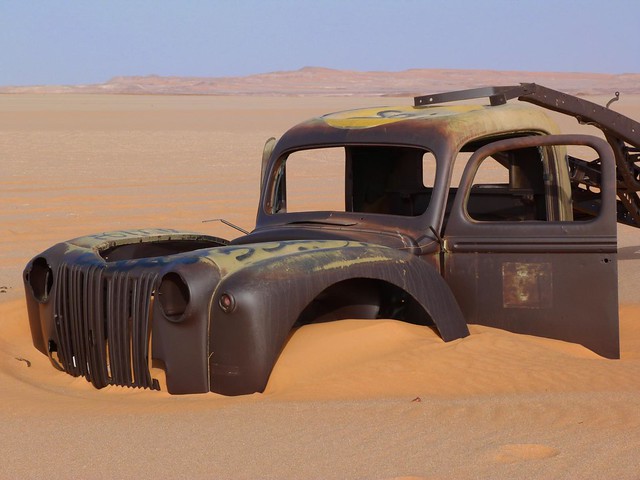
Camp among the dunes
The site chosen for the camp today is my favorite since we started the expedition Kamal. With the Gilf Kebir plateau just one step, and really almost three Egyptian border southwest, we stand now in a clearing surrounded by kilometers and kilometers of fine golden dunes. The silence of an early night was interrupted by the team of drivers and cooks who have taken the djembe and darbuka to give Egyptian rhythm to an increasingly cohesive international group. Awhile before dinner a few kebabs with rice have been able to listen to Emmanuel Honoré, a French archaeologist who has contextualized sites and prehistoric caves in just a day or two will be able to observe in situ during our trip.

Gilf Kebir and Jebel Uweinat are ran rich in rock art that has known much more of whom Herodotus called "Ethiopian troglodytes" (auque with Ethiopian he meant black) with the interpretation of a heavily laden with symbolism drawings and tell us which makes less than ten thousand years this part of the Sahara should be very possibly a blanket full of lakes and wildlife we should now go get to Kenya or Tanzania. A very conducive to life and the establishment of semi-nomadic villages born in the same foothills of the mountain.
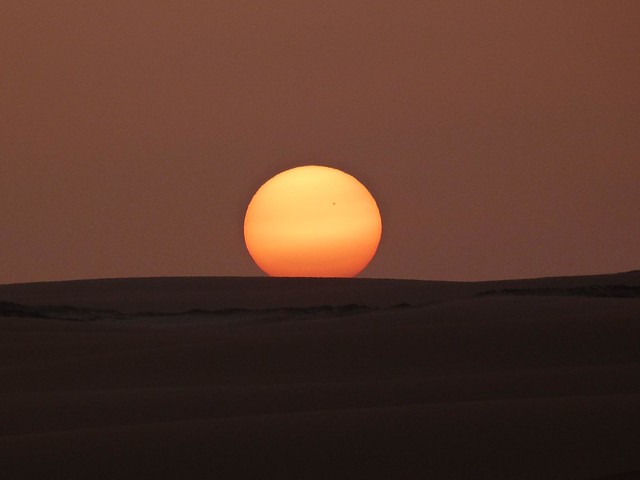
The Almasy found itself more than twenty cave paintings, but the most famous was known as "swimmers". It is less to reach Wadi Sura (the Valley of the images) and witness live this artistic expression that explains how many thousands of years man was related to their environment in a way very different from today. The desertification of the Sahara did the rest for this to be a lonely, empty ... and so interesting to know land.
Still they are echoing the darbukas. Meanwhile, a nearly full moon watching us from up high ...
March 17, 2014: Day 5
A plain land thicker sand yesterday without a single hill breaking the horizon, has helped us to set up camp. We have a full moon and the wind blows just leaving for the first time, a really peaceful night and nothing cold. I write these notes with a shy but sincere smile. Grimace caused by that at the moment has been the most intense and entertaining from the start of the Expedition Kamal day. The extremely long journeys ended and began the good. Today at last we reached the plateau of Gilf el Kebir, a plateau thickness of over a thousand meters above the sea and especially round the landscape increasingly amazing Western Desert. The purpose of our trip we have sighted timidly entering the extreme southeast, entering some of its arid and rocky wadis (valleys) and in the evening paying homage to the board in marble László Almásy deposited in southern Gilf el Kebir to his patron and close friend Hussein Kamal el Din, died from an infection in Toulouse just as he was about to start the search longed Zerzura Oasis in 1933. The Prince was its main supporter and even there who says that Almasy and he did not only they are admired by the momentum of clear "white spots" map of Egypt but were a narrowness between erased from the collective memory even for obvious historical reasons.
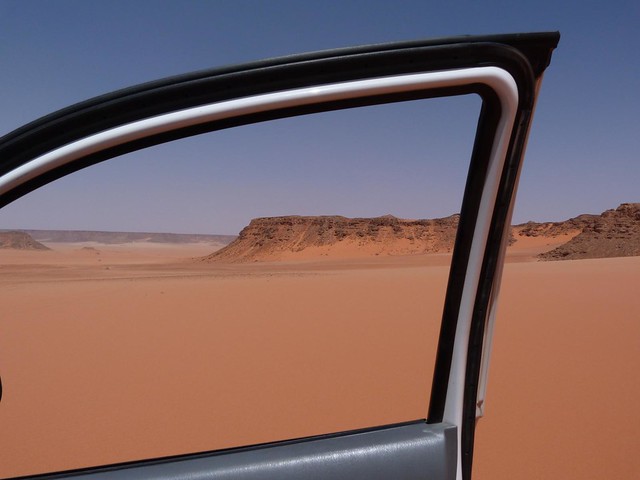
But before reaching the monument to Kamal, the name given to our expedition, we crossed ranging grotesquely excellent views in just a kilometer away. First a series of rolling dunes and yellow in which more than one vehicle is stuck. Without being too high, no more than ten meters, became difficult to maintain the tires out of his mouth. Fortunately our driver, Mohammed, knows everything went well and stopped all obstacles encountered since the start of the trip.
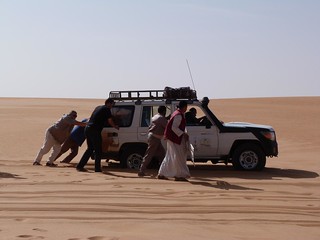
8 Bells, an esplanade turned into airport during the war
After the road has become increasingly easier. We shot for 20 kilometers sandy soil have drawn a vast expanse painted a row of eight orange hills. No we could not believe it, we had arrived at last to 8 Bells, a makeshift airfield that served for entry and exit of aircraft during World War II. Some drums 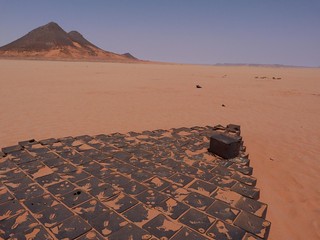 Shell petrol perfectly aligned in an arrow will be anchored to the ground during the war by the British military provisions of the Sahara Desert, the Long Range Desert Group (LRDG). The purpose guide the planes in a really great and perfect conditions for landing, takeoff space and, of course, refueling on the way they did between Kufra (Libya) and cities like Aswan (Egypt) and Dongola (in present Sudan). The British gave him the name of 8 Bells because the surrounding hills are bell-shaped. Since then it became a strategic and essential place in the vast Libyan Desert for which compatían Allies and Nazis with Rommel to the head and maps and advice Almasy the German side, something not mentioned in the film of The English Patient, which is the figure of the Hungarian way too romantic, too immaculate. To know more about this topic recommend to carry out the reading of "The Secret Life of Laszlo Almasy: The Real Inglés Patient" by John Bierman addition to the collection of the works of Almasy himself in "Swimmers in the desert", which It gathers documentation that remained secret and has firsthand how does introduce two German spies in Cairo touring the western desert of Egypt.
Shell petrol perfectly aligned in an arrow will be anchored to the ground during the war by the British military provisions of the Sahara Desert, the Long Range Desert Group (LRDG). The purpose guide the planes in a really great and perfect conditions for landing, takeoff space and, of course, refueling on the way they did between Kufra (Libya) and cities like Aswan (Egypt) and Dongola (in present Sudan). The British gave him the name of 8 Bells because the surrounding hills are bell-shaped. Since then it became a strategic and essential place in the vast Libyan Desert for which compatían Allies and Nazis with Rommel to the head and maps and advice Almasy the German side, something not mentioned in the film of The English Patient, which is the figure of the Hungarian way too romantic, too immaculate. To know more about this topic recommend to carry out the reading of "The Secret Life of Laszlo Almasy: The Real Inglés Patient" by John Bierman addition to the collection of the works of Almasy himself in "Swimmers in the desert", which It gathers documentation that remained secret and has firsthand how does introduce two German spies in Cairo touring the western desert of Egypt.
 Shell petrol perfectly aligned in an arrow will be anchored to the ground during the war by the British military provisions of the Sahara Desert, the Long Range Desert Group (LRDG). The purpose guide the planes in a really great and perfect conditions for landing, takeoff space and, of course, refueling on the way they did between Kufra (Libya) and cities like Aswan (Egypt) and Dongola (in present Sudan). The British gave him the name of 8 Bells because the surrounding hills are bell-shaped. Since then it became a strategic and essential place in the vast Libyan Desert for which compatían Allies and Nazis with Rommel to the head and maps and advice Almasy the German side, something not mentioned in the film of The English Patient, which is the figure of the Hungarian way too romantic, too immaculate. To know more about this topic recommend to carry out the reading of "The Secret Life of Laszlo Almasy: The Real Inglés Patient" by John Bierman addition to the collection of the works of Almasy himself in "Swimmers in the desert", which It gathers documentation that remained secret and has firsthand how does introduce two German spies in Cairo touring the western desert of Egypt.
Shell petrol perfectly aligned in an arrow will be anchored to the ground during the war by the British military provisions of the Sahara Desert, the Long Range Desert Group (LRDG). The purpose guide the planes in a really great and perfect conditions for landing, takeoff space and, of course, refueling on the way they did between Kufra (Libya) and cities like Aswan (Egypt) and Dongola (in present Sudan). The British gave him the name of 8 Bells because the surrounding hills are bell-shaped. Since then it became a strategic and essential place in the vast Libyan Desert for which compatían Allies and Nazis with Rommel to the head and maps and advice Almasy the German side, something not mentioned in the film of The English Patient, which is the figure of the Hungarian way too romantic, too immaculate. To know more about this topic recommend to carry out the reading of "The Secret Life of Laszlo Almasy: The Real Inglés Patient" by John Bierman addition to the collection of the works of Almasy himself in "Swimmers in the desert", which It gathers documentation that remained secret and has firsthand how does introduce two German spies in Cairo touring the western desert of Egypt.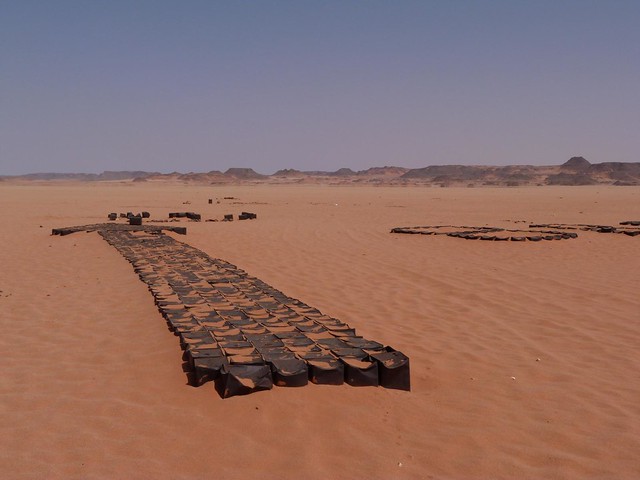
Traces of war impressed me, and in this remote place. That and the extremely dry weather conditions have allowed drums and even cans of food they already have over seventy years old are preserved. Not to mention the vehicles stuck in the sand we dealt with yesterday. Certainly the area around Gilf Kebir is unwittingly an authentic outdoor museum of what happened in North Africa during World War II.

We have heeded arrow made with drums and we have come after her in this natural airfield to leave the flat and start climbing by a wavy road composed entirely black stones and red sand. There have been some difficult stretches where more than one has touched literally "bite the dust" and need to push to get the vehicle unstuck. The landscape within minutes has changed dramatically and we were walking seemed territory of Mars or who knows what planet beyond Earth.

Welcome to Gilf Kebir
It was the foothills of Gilf Kebir was beginning to show its southeastern slope and wet our lips with the delicious honey. They were just the first post of this lonely and masterful corner of nature in Egypt and our faces exhaustion had taken on a genuine gesture hallucination. It would be so throughout the day when we have really begun to realize where we are, that's such a treasure of unknown Sahara was taking off her clothes in front of our noses. When I travel I always try to tell myself "Remember where you are, you assimilate you are in a privileged position." Always good to take certain items 100% to appreciate what you're doing. Thus the adventure is much more enjoys one minute becomes more than a minute. The routine places like this does not exist, as well as time. In fact to put the date in the present day I had to ask what day we met. But how wonderful is it to lose track of time!

We picked up speed in the Wassa Valley, raising a huge cloud of dust until the car Tarek, the leader of the expedition, has stopped just in front of a rock wall. The Tarek himself has begun to climb sand leaning how could in some stones, and sat under a rock overhang. It's expected that others arrived and when we have done has asked us to look the roof of that ledge. In that time we have realized that we were facing our first rock paintings in this area of Western Desert. A few animals were painted red, and said cavity painted about 8000 years ago was discovered in 2013 by a group of travelers who were with Tarek own. Not to say that this place remains an absolute and wonderful enigma ...

These animal representations remind us that the Sahara was not a desert for ten millennia, but rather a blanket as there may be in Kenya or Tanzania. The presence of giraffes, lions and antelopes in the various walls of Gilf Kebir and Jebel Uweinat we are really telling how were those wadis, or valleys before desertification converted this area into one of the most arid, empty and lonely Planet territories.
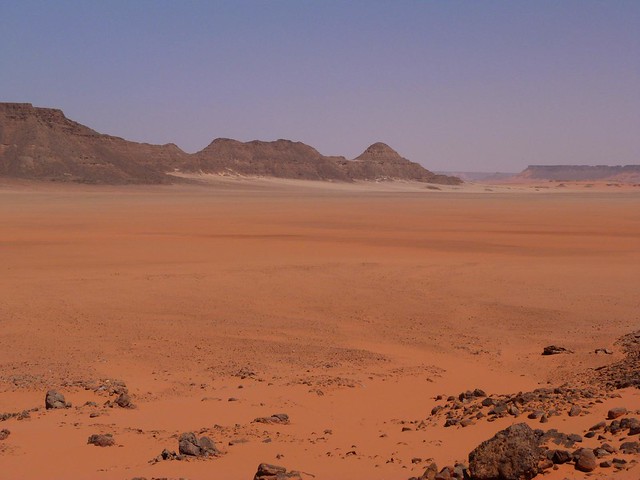
Magharet the rock cave in Wadi El Qantara Wassa
But that was just an appetizer. Later, in about twenty to thirty minutes at a normal speed, we would visit a much larger and impressive cavity Magharet El Qantara (which means "bridge" for the way it has this gap in the mountains). Originally discovered in 1935 the track was lost until 1996 when the expedition returned a find. We have uploaded a slope of no more than twenty meters and we have lying directly to observe the ceilings. Before our eyes was another representation of animals, particularly cattle or cows, with a composition of simple colors of ocher and white. Even one of the figures looked like a giraffe long neck, but none have come to have it too clear.
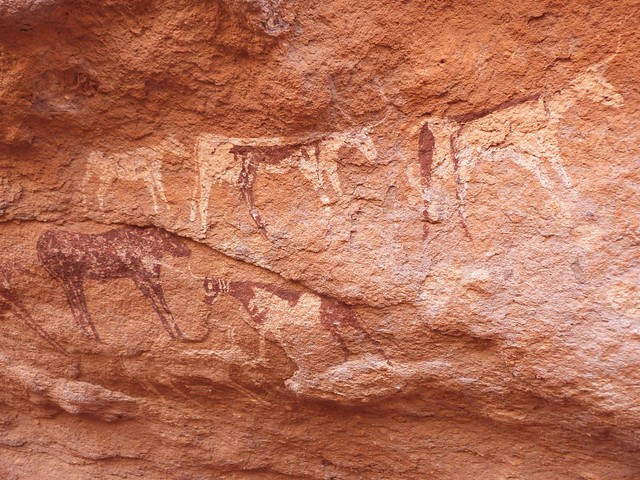
This gap is sufficiently protected in the valley, it has prodigious views and their necessary time for the men who lived there could detect and monitor what they wanted to hunt. This is one of the more than thirty representations that were discovered in the twenties and thirties and makes this one of the most important prehistoric North African areas. E essential to understand Egypt and join posterior bridges with a highly advanced civilization that built great pyramids and know their environment perfectly. The question is whether there is a real relationship between the nomads who painted giraffes in those caves and erected soon after Luxor, Karnak or were embalmed with countless treasures in the Valley of the Kings. I really do not know. In fact, for many hypotheses that may be in the history books, no one knows.
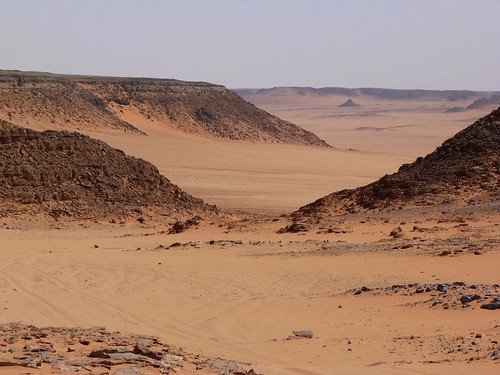
At the foot of Prince Kamal el Din
We lunch at the foot of the mountain and we continued our way Gilf Kebir leaving to our left. There was still one of the highlights of the trip, arrival at the commemorative plaque Almasy and his men put in 33 in honor of Prince Kamal moments. A humble stone building upon each other and cracked marble plate are more than the beacon who got here revere as the most famous temples. In a way that small "memory" has moved an adventure that has taken almost two years of preparation.
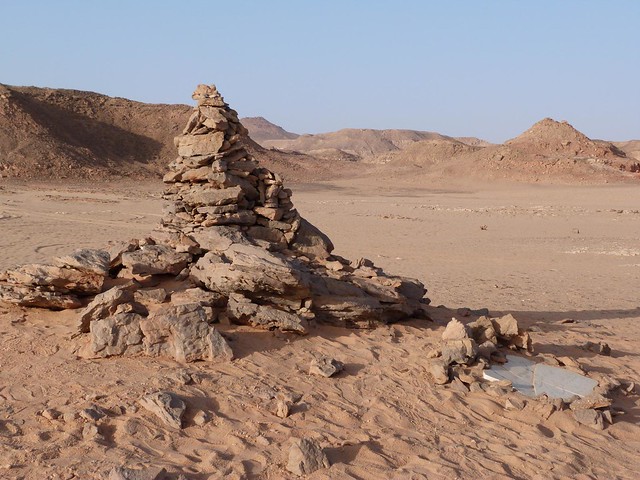
The setting is wonderful and the building is so humble that he does not need anything else to be perfect. Apparently written in Arabic plate was located in the column of stones but returned a year later Amásy saw that he had fallen, so he decided to join the pieces and finally put her down. We left there the commemorative book Expedition Kamal with the signatures of all the members of it. We have also seen a box full of notes and cards from other people who have come to the monument to the intrepid Egyptian prince. I left a note thanking those pioneers who helped us discover our world and why we are here today in the Libyan Desert.
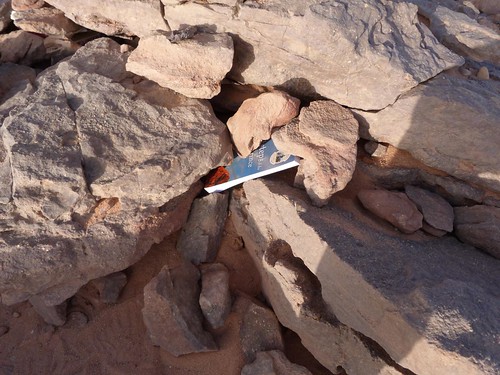
There is a monument in itself, but its meaning, the facts surrounding it and those mountains of the southern tip of the Gilf Kebir amazing. Soon we return to hug the west, since we started south toward Jebel Uweinat, this solid shared between Egypt, Sudan and Libya, which also hides secrets.

The silence makes me think that arrow drums, in animals painted in caves thousands of years ago in a very supernatural landscape away from any civilization, comfort or technology. This is still what looked like Kamal, Almasy and company, remains the desert to which we can never leave again in our lifetime
No comments:
Post a Comment